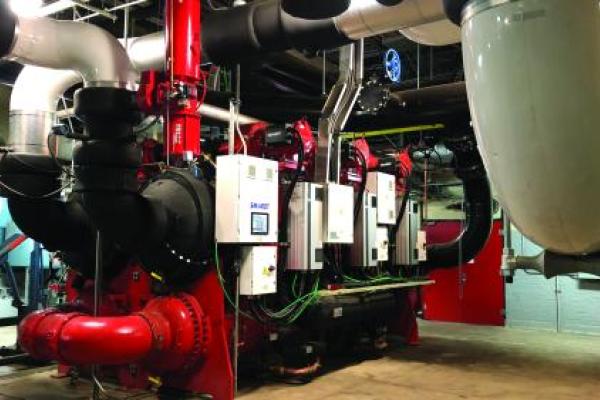Medical
Like many universities across America, The University of Cincinnati had a major challenge having to operate aging central utility plants with older technology, reduced efficiencies and capacities, with chilled water equipment at the end of its service life. Even so, UC needed to maintain plant operations under diverse load conditions, including critical hospital utility demands that are currently expanding and in daily periods subject to energy tariff.
A technology called, “cool storage” offers a reliable, cost-effective means of managing electricity costs while ultimately helping to limit greenhouse gas emissions. The technology allows facilities to take advantage of less costly electricity available at night and functionally save that energy for use at a later time. Cool storage achieves this performance by using ice or chilled water as a medium for storing and deploying energy.
[ Read Full Story ]
Hospitals account for nearly 5% of the total energy use in the United States each year. The average 200,000 ft2 facility spends about $13,600 per bed, or roughly $680,000 annually, on energy costs. Why so much? Operating twenty-four hours a day, thousands of employees, patients, and visitors cycle through campus buildings daily. Additionally, hospitals maintain high ventilation rates to lessen the risk of microbial contamination; the conditioning requirements of this outdoor air represents significant energy usage. Lastly, the use of sophisticated imaging equipment, electronic health record systems and other operations generates heat that must be compensated for via the site’s cooling load.
[ Read Full Story ]
Chiller & Cooling Best Practices Magazine spoke with Tom Pagliuco, Executive Director Global Energy Engineering at AbbVie, Inc. about best practices for optimizing chilled water systems in today’s pharmaceutical operations.
[ Read Full Story ]
When a cooling tower supporting the HVAC system at NYC Health + Hospitals/Lincoln was nearing its expected end of life, the management of the 362-bed hospital in the South Bronx saw an opportunity. The year before, the neighboring community had experienced outbreaks of Legionnaires’ disease, and even though the hospital’s cooling towers played no role in those outbreaks, the chance to increase protections against possible future exposures of the bacteria that cause the disease was an important consideration.
[ Read Full Story ]
Penn State Health Milton S. Hershey Medical Center, Hershey Pa., is all about energy and resource efficiencies, which is why it adopted a new approach to managing its chilled water operation. The approach, which revolves around a software and analytics platform used to optimize three chiller plants in addition to various equipment upgrades, has allowed it to save 4.16 GWh/yr in electrical energy consumption – and shave $300,000 off of its annual electrical costs. With an incentive from the local utility of $415,799, the multi-phased initiative achieved a payback of 4.3 years.
[ Read Full Story ]
The Institute for Bioscience and Biotechnology Research (IBBR) connects scientists from the University of Maryland, the National Institute of Standards and Technology, and industry to find solutions to major scientific and medical challenges. With one of the nation’s largest collections of high-resolution instruments, they look inside cells and manipulate molecules. IBBR researchers have figured out the molecular structure of proteins, unraveled the protein interactions involved in autoimmune disorders and discovered possible countermeasures for antibiotic resistance.
[ Read Full Story ]
Industrial cooling and refrigeration equipment used in manufacturing and environmental control rely heavily on water to either cool, or otherwise regulate product or formulation temperature during processing. While such equipment can appear to function efficiently without input of truly pure water, the unknown cumulative build-up of scale and corrosion would be costly due to high maintenance, related damage, reduced efficiency, and ultimately, premature equipment failure.
[ Read Full Story ]
HVAC systems can consume thirty percent (30%) of the total building energy needed in library, student union and classroom facilities. In laboratory and research facilities, the HVAC energy consumption can be up to sixty percent (60%). When one considers the data of traditional airside Energy Conservation Measures (ECMs), simple paybacks range from low-cost, quick paybacks to capital-intensive long paybacks. The ECMs range from simple strategies, such as night setback and/or supply air reset, to full air handler replacement or variable air volume from constant volume conversion. However, few ECMs deliver more than thirty-five percent (35%) savings for the entire university campus.
[ Read Full Story ]

